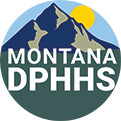Traveler Health

Whether you are traveling to Montana or abroad, it is important to understand the risks associated with your travel destination when preparing for travel.
General Advice for Travelers
- Check the CDC Travel Destination page for your target destination to see what vaccines or medicines you may need prior to leaving for your trip.
- Make an appointment with your healthcare provider or a travel health specialist that takes place at least 6 weeks prior to your departure. This ensures that you have time to receive all necessary vaccines or medicines prior to your trip.
- Bring a copy of your official immunization records with you when you travel. Montanan's can request a copy of their immunization record here.
- Take any prescribed medicines as directed by your provider before, during, and/or after travel. Learn more about traveling abroad with medicine here.
- Find out if your health insurance covers medical care abroad. Even if you are traveling to a country with nationalized health care, it may not cover the cost of medical services for people who are not citizens. Consider adding a short-term supplemental travel health insurance policy to your existing plan in the event that you need to seek health care abroad or need a medical evacuation.
- Prepare a travel health kit with items you may need. Some examples of items to include to help prevent the spread of or reduce the severity of symptoms of communicable diseases include insect repellent, anti-diarrheal and anti-nausea medication, alcohol-based hand sanitizer, and water disinfection tablets.
Hand and Respiratory Hygiene
- Wash your hands frequently with soap and water. If soap and water are not available, use an alcohol-based hand sanitizer that contains at least 60% alcohol.
- Avoid touching your eyes, nose, or mouth with unwashed hands.
- Wearing a mask can help lower the risk of respiratory virus transmission. When worn by a person with an infection, masks reduce the spread of the virus to others. Masks can also protect wearers from breathing in infectious particles from people around them.
Prevent Bug Bites
- Use an EPA-registered insect repellent with one of the following active ingredients: DEET, picaridin, IR3535, oil of lemon eucalyptus/para-menthane-diol, or 2-undecanone.
- If using insect repellent with sunscreen, apply your sunscreen first, let it dry, and then apply your insect repellent.
- Wear long-sleeved shirts and long pants when outdoors. You may also treat your clothing and gear with permethrin (an insecticide that kills or repels insects like mosquitoes and sand flies).
- Sleep under a mosquito net.
Choose Safe Food and Drinks
- Cold food should be served cold, and hot food should be served hot. Avoid foods that are lukewarm (between 40°F and 140°F), especially if they have been sitting out at a buffet or salad bar, for example.
- Avoid dairy products if you are unsure if they have been pasteurized (e.g., raw cheeses and yogurts).
- Pasteurized milk from a sealed bottle is usually safe to drink while abroad. Do not drink milk stored in open containers, such as pitchers, that may have been sitting at room temperature; this includes cream for coffee or tea. Unpasteurized foods carry risks for all travelers; however, it is especially important for pregnant women or people who have a weakened immune system to avoid unpasteurized milk, cheese, and yogurt.
- Avoid eating raw foods, including raw meat or seafood. Raw fruits or vegetables may be safer to eat if you can peel them yourself or wash them in bottled or disinfected water.
- Avoid drinking tap water in countries where the tap water might be contaminated. When visiting places with unknown water quality, disinfect the water before consuming it. Tap water can be disinfected by boiling, filtering, or chemically treating it.
- Avoid drinks with ice in destinations with limited access to clean water or where there is a concern about contaminated drinking water, as ice is frequently made with tap water.
Avoid Animals
- Avoid petting and feeding animals, even pets, while traveling internationally as they may not be vaccinated against rabies or other diseases.
- Seek medical attention after animal encounters, such as bites or scratches, as you may need treatment to prevent or stop an infection.
- Contact your healthcare provider if you feel sick after your trip. Be sure to communicate key details about your travel, such as:
- Your vaccination history.
- Where you traveled.
- Your reasons for traveling.
- Your travel activities, including swimming, hiking, etc.
- The timeframe of your vacation.
- Where you stayed, such as hotels, family or friends’ homes, hostels, or tents.
- What you ate and drank.
- Animals you had close contact with or touched.
- If you have any injuries, scratches, or bug bites.
- Health care or medications you received during your trip.
- Close contact with other people, including sexual encounters.
- If you got any tattoos or piercings.
- If you are a long-term traveler, such as expatriate workers, Peace Corps volunteers, or missionaries, you may have a greater risk of getting sick during travel. Consider having a thorough medical exam or interview with your healthcare provider after you return to the United States.
Resources for Travelers Coming to Montana
Foodborne and Waterborne Diseases
- Campylobacteriosis
- Salmonellosis
- Norovirus
- Hepatitis A
- Shiga toxin-producing Escherichia coli (STEC)
- Cryptosporidiosis
- Giardiasis
Zoonotic and Vector-borne Diseases
- Rabies
- Hantavirus
- West Nile Virus
- Tickborne Diseases
Viral Respiratory Illnesses
- COVID-19
- Influenza
- Respiratory Syncytial Virus (RSV)
Vaccine Preventable Diseases
- Pertussis (Whooping Cough)
- Varicella (Chickenpox)
Sexually Transmitted Diseases
- Chlamydia
- Gonorrhea
- Syphilis
- Human Immunodeficiency Virus (HIV)
Other Diseases of Concern in Montana
- Tuberculosis and Latent Tuberculosis Infection
- Chronic Wasting Disease (CWD)
Cascade County:
Flathead County:
Gallatin County:
Lewis and Clark County:
Missoula County:
Silver Bow County:
Additional Resources:
Resources for International Travel
- Smart Traveler Enrollment Program (STEP)
- The Smart Traveler Enrollment Program is a free service that allows U.S. citizens traveling or living abroad to receive the latest security updates from the nearest U.S. embassy or consulate.
- Travel Health Notice
- Travel Advice, Resources, and Partners
- Travel FAQs
Each year, millions of Americans travel internationally for medical care, which is called "medical tourism". Medical tourists from the United States most commonly travel to Mexico and Canada, but also frequent countries in Central America, South America, and the Caribbean.
People may seek medical care in another country for various reasons, including:
- Cost: To get a treatment or procedure that may be cheaper in another country
- Culture: To receive care from a clinician who shares the traveler’s culture and language
- Unavailable or unapproved procedures: To get a procedure or therapy that is not available or approved in the United States
Traveling to another country to get medical care can be risky. Learn about the risks associated with medical tourism below.
- Infectious Disease. All medical procedures have some risk of infection. Complications from procedures performed in other countries include wound infections, bloodstream infections, donor-derived infections (in the case of transplantations or transfusions), and diseases such as hepatitis B, hepatitis C, and HIV.
- Antibiotic resistance. Highly drug-resistant bacteria and fungi have caused disease outbreaks among medical tourists. Antimicrobial resistance happens when germs develop the ability to not respond to drugs such as antibiotics used to treat infections. Antimicrobial resistance is a global problem. Every country has varying levels of resources and might face different antibiotic resistance threats. For example, some countries have limited capacity to diagnose and track antimicrobial-resistant germs in healthcare facilities, which adds to the difficulty of implementing effective treatment and prevention programs.
- Quality of Care. Some countries’ requirements for maintaining licensure, credentialing, and accreditation may also be less than what would be required in the United States. In some countries, counterfeit medicines and lower quality medical devices may be used.
- Communication challenges. Communicating with staff at the destination and healthcare facility may be challenging. Receiving care at a facility where you do not speak the language fluently could lead to misunderstandings about your care.
- Air Travel. Flying after surgery can increase the risk for blood clots, including deep vein thrombosis. Delaying air travel for 10-14 days following major surgeries, particularly those involving the chest, will minimize risks associated with changes in atmospheric pressure.
- Continuity of Care. Travelers may need to get health care in the United States if they develop complications after returning. Follow-up care for complications might be expensive. Treatment might be prolonged and might not be covered by your health insurance.
Learn how to minimize medical tourism risks by visiting Medical Tourism: Travel to Another Country for Medical Care | Travelers' Health | CDC.

